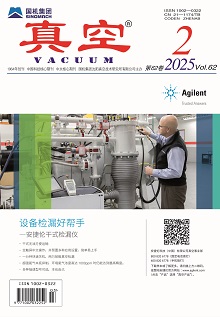|
|
Effect of Thickness on Structure and Properties of Cr-CrN-Cr-CrAlN Multilayers
LIN Song-sheng, LIU Ruo-yu, TIAN Tian, LÜ Liang, SU Yi-fan, WANG Yun-cheng, SHI Qian, YUN Hai-tao, TANG Peng, ZHENG Cai-feng, YI Chu-shan
VACUUM
2023, 60 (4):
1-7.
DOI: 10.13385/j.cnki.vacuum.2023.04.01
In order to study the effect of thickness on structure and properties of Cr-CrN-Cr-CrAlN coatings, multilayer coatings with different thicknesses were prepared on TC4 titanium alloy by vacuum cathodic arc ion plating. Scanning electron microscope(SEM), X-ray diffraction(XRD), microhardness tester, scratch tester, stress tester, sand erosion tester and tensile tester were used to analyze and detect the surface and cross-section morphology, structure, thickness, hardness, adhesion, residual stress, sand erosion resistance and tensile property of the multilayers. The results show that with the increase of multilayer thickness, particles on the surface of the film increase,the surface quality of the coatings decreases slightly and the coating growth orientation changes from (200) to (111) crystal plane. With the increase of multilayer thickness, the internal stress of the coatings increases, and the hardness, adhesion strength, crack propagation resistance increase first and then decrease. When the thickness is 10.58μm, the optimal mechanical properties with hardness of 3404HV, binding force of 58.6N, crack growth resistance of 758.49 are obtained, and the erosion resistance increases by more than 3 times. After TC4 titanium alloy surface is coated with multilayer film,the yield strength and tensile strength of TC4 are slightly increased, while the elongation after fracture is decreased. In particular, when the thickness of the coating reaches 14.50μm, the elongation after fracture is reduced by 30% compared with that of the substrate. Increasing the coating thickness in a certain range is beneficial to improving the mechanical properties. However, it needs to be controlled to reduce the negative impact on the mechanical properties of titanium alloy substrate.
Reference |
Related Articles |
Metrics
|
|

